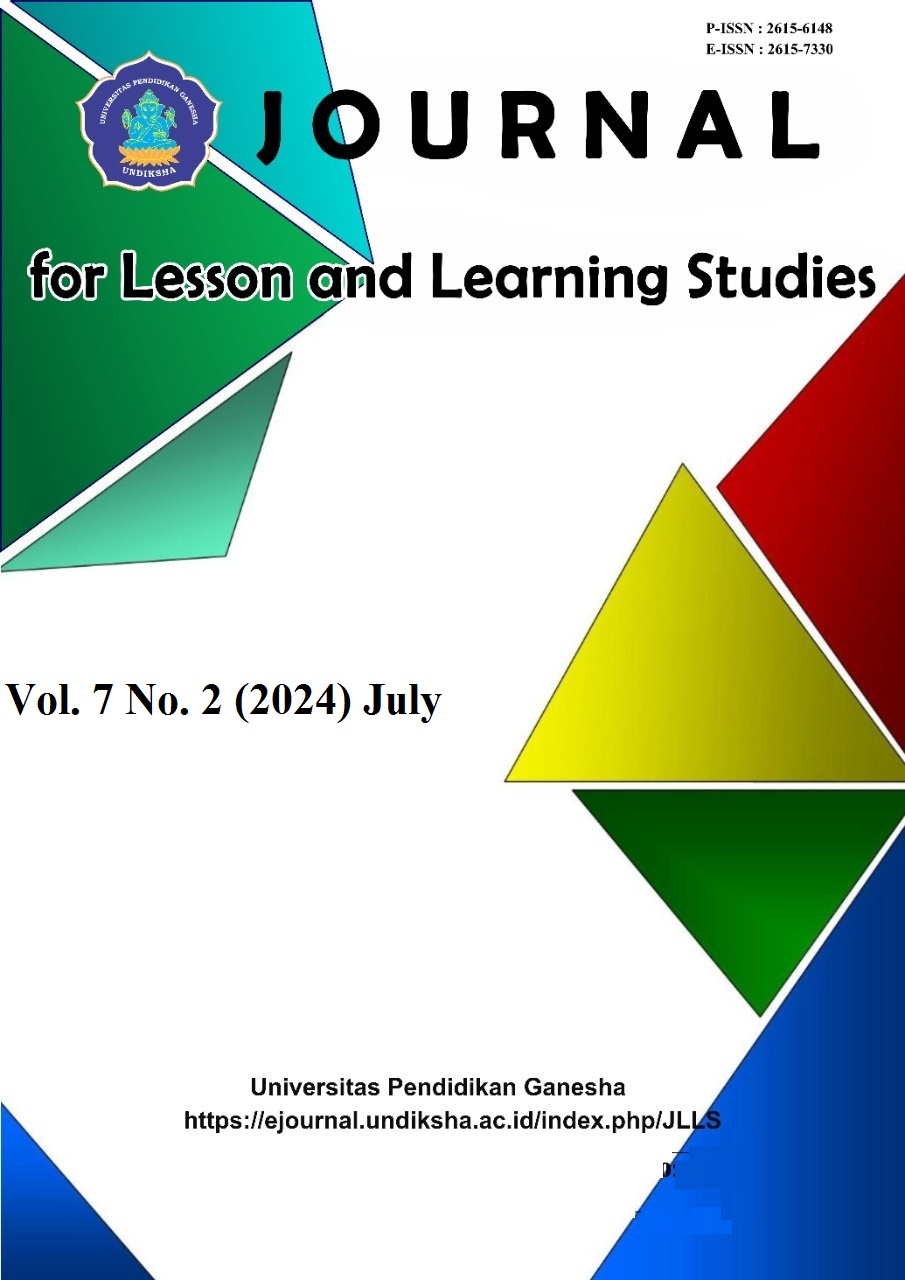The Impact of Debate Method on Prospective Elementary Schools’ Communication Ability
DOI:
https://doi.org/10.23887/jlls.v7i2.77309Kata Kunci:
Communication Skills, Debate Methods, Social Studies LearningAbstrak
Social studies education is very important for training communication skills in students up to college, because debate method training is an alternative for forcing students to communicate through pressure (pro-con opinions). This research aims to analyze the relationship between the use of the debate learning model and students' communication skills in MI/SD Basic Social Sciences learning. The type of research used is Quasi Experiment with a Nonequivalent Pretest-Posttest Control Group Design research design. Data collection techniques using questionnaires and documentation. The results of the research are that the average result of the experimental class pretest is in the 0-54 interval, namely 53.53 and is in the very low criteria. Meanwhile, the control class pretest results were in the 0-54 interval, namely 47.30 and were in the very low criteria. The average results of the experimental class post-test were in the 65-79 interval, namely 65.43 and were in the medium criteria, while the control class post-test results were in the 0-54 interval, namely 50.53 and were in the very low criteria. . The probability value for the hypothesis test results, namely (2-tailed) is 0.000. Thus, Ha is accepted, Ho is rejected because 0.000<0.005, so it can be concluded that there is a significant difference in the average score of the communication ability test in the experimental group and the control group.
Referensi
Abad-Segura, E., González-Zamar, M. D., Infante-Moro, J. C., & García, G. R. (2020). Sustainable management of digital transformation in higher education: Global research trends. Sustainability (Switzerland), 12(5), 1–24. https://doi.org/10.3390/su12052107.
Agustini, K., Santyadiputra, G. S., & Sugihartini, N. (2020). Visualizing the stages of the educational research methodology into animation infographics for vocational students. Jurnal Pendidikan Vokasi, 9(3), 317–327. https://doi.org/10.21831/jpv.v9i3.22017.
Ali, B. J., & Anwar, G. (2021). Vocabulary Learning Strategies and Foreign Language Acquisition at Private Schools. International Journal of English Literature and Social Sciences, 6(3), 163–173. https://doi.org/10.22161/ijels.63.24.
Amira, F., & Amri, Z. (2022). Students’ Speaking Ability on YouTube Video Project in Online Class during Covid19 Pandemic at Universitas Asahan. Proceedings of the 67th TEFLIN International Virtual Conference & the 9th ICOELT 2021 (TEFLIN ICOELT 2021), 624, 88–92. https://doi.org/10.2991/assehr.k.220201.016.
Asrial, A., Syahrial, S., Kurniawan, D. A., Subandiyo, M., & Amalina, N. (2019). Exploring obstacles in language learning among prospective primary school teacher. International Journal of Evaluation and Research in Education, 8(2), 249–254. https://doi.org/10.11591/ijere.v8i2.16700.
Beneroso, D., & Robinson, J. (2022). Online project-based learning in engineering design: Supporting the acquisition of design skills. Education for Chemical Engineers, 38(October 2021), 38–47. https://doi.org/10.1016/j.ece.2021.09.002.
Cahyo, E. D. (2016). Pengaruh penerapan metode problem based learning dalam meningkatkan pemahaman konsep dasar IPS dan kemampuan berpikir kritis siswa. Jurnal Pedagogik Pendidikan Dasar, 4(1), 114–127.
http://download.garuda.kemdikbud.go.id/article.php?article=2456279&val=23417.
Cantú-Ortiz, F. J., Galeano Sánchez, N., Garrido, L., Terashima-Marin, H., & Brena, R. F. (2020). An artificial intelligence educational strategy for the digital transformation. International Journal on Interactive Design and Manufacturing, 14(4), 1195–1209. https://doi.org/10.1007/s12008-020-00702-8.
Chang, C. (2018). Foreign Language Learning Strategy Use Profile of University Students in Taiwan and Japan. Electronic Journal of Foreign Language Teaching, 15(2), 373–387. https://e-flt.nus.edu.sg/wp-content/uploads/2020/09/chang.pdf.
Chen, H.-W., Wu, J.-C., Kang, Y.-N., Chiu, Y.-J., & Hu, S. H. (2023). Assertive communication training for nurses to speak up in cases of medical errors: A systematic review and meta-analysis. Nurse Education Today, 126, 105831. https://doi.org/10.1016/j.nedt.2023.105831.
Dowell, N. M. M., Lin, Y., Godfrey, A., & Brooks, C. (2020). Exploring the relationship between emergent sociocognitive roles, collaborative problem-solving skills, and outcomes: A group communication analysis. Journal of Learning Analytics, 7(1), 38–57. https://doi.org/10.18608/jla.2020.71.4.
Dunbar, N. E., Brooks, C. F., & Kubicka-Miller, T. (2006). Oral communication skills in higher education: Using a performance-based evaluation rubric to assess communication skills. Innovative Higher Education, 31(2), 115–128. https://doi.org/10.1007/s10755-006-9012-x.
Edwards-Schachter, M., García-Granero, A., Sánchez-Barrioluengo, M., Quesada-Pineda, H., & Amara, N. (2015). Disentangling competences: Interrelationships on creativity, innovation and entrepreneurship. Thinking Skills and Creativity, 16, 27–39. https://doi.org/10.1016/j.tsc.2014.11.006.
Febriana, F. D., & Sakti, N. C. (2021). Pengembangan E-Modul Berbasis Kontekstual Sebagai Pendukung Pembelajaran Jarak Jauh Kelas X Ips. Jurnal PROFIT Kajian Pendidikan Ekonomi Dan Ilmu Ekonomi, 8(1), 47–58. https://doi.org/10.36706/jp.v8i1.14057.
Fei, Z., & Ding, L. (2021). Research on Teaching Innovation of Basic Courses of Ideological and Political Education in Universities Integrating Computer Multimedia Technology. 2020 International Conference on Mechanical Automation and Computer Engineering, MACE 2020, 1744(4). https://doi.org/10.1088/1742-6596/1744/4/042123.
Fernández-Villarino, R. (2021). Sustainability in the football industry: An approach to the gap between theoretical formulation and practical application, through the results of the social fair play project. Heliyon, 7(6), e07318. https://doi.org/10.1016/j.heliyon.2021.e07318.
Garner, P. W., Gabitova, N., Gupta, A., & Wood, T. (2018). Innovations in science education: infusing social emotional principles into early STEM learning. Cultural Studies of Science Education, 13(4), 889–903. https://doi.org/10.1007/s11422-017-9826-0.
Gong, M., Simpson, A., Koh, L., & Tan, K. H. (2018). Inside out: The interrelationships of sustainable performance metrics and its effect on business decision making: Theory and practice. Resources, Conservation and Recycling. https://doi.org/10.1016/j.resconrec.2016.11.001.
Hadi, M. S., Izzah, L., & Masae, M. (2021). Factors affecting speaking anxiety of Thai students during oral presentation: Faculty of Education in TSAI. https://jurnal.umj.ac.id/index.php/ELIF/article/view/8897.
Holland-Batt, S., & Jeffery, E. (2021). Debate, discourse and productive disagreement: interrogating the performative dimensions of authorship in the creative writing classroom. New Writing, 18(2), 213–228. https://doi.org/10.1080/14790726.2020.1788103.
Koesoemadinata, M. I. P. (2022). Visual Adaptation Of Wayang Characters In Teguh Santosa’s Comic Art. Mudra Jurnal Seni Budaya, 33(3), 401. https://doi.org/10.31091/mudra.v33i3.544.
Kurniawati, F. N., Susanto, S., & Munir, A. (2019). Promoting Students’ Communication Skill through the Application of Project Based Learning. Linguistic, English Education and Art (LEEA) Journal, 3(1), 26– 44. https://doi.org/10.31539/leea.v3i1.970.
Lamb, P., & Aldous, D. (2016). Exploring the relationship between reflexivity and reflective practice through lesson study within initial teacher education. International Journal for Lesson and Learning Studies, 5(2), 99–115. https://doi.org/10.1108/IJLLS-11-2015-0040.
Lavania, M., & Nor, F. B. M. (2020). Barriers in differentiated instruction: A systematic review of the literature. Journal of Critical Reviews, 7(6), 293–297. https://doi.org/10.31838/jcr.07.06.51.
Magnússon, G., Göransson, K., & Lindqvist, G. (2019). Contextualizing inclusive education in educational policy: the case of Sweden. Nordic Journal of Studies in Educational Policy, 5(2), 67–77. https://doi.org/10.1080/20020317.2019.1586512.
Martin, A., & Grudziecki, J. (2006). DigEuLit: Concepts and tools for digital literacy development. Innovation in Teaching and Learning in Information and Computer Sciences, 5(4), 249–267. https://doi.org/10.11120/ital.2006.05040249.
Mee Mee, R. W., Shahdan, T. S. T., Ismail, M. R., Abd Ghani, K., Pek, L. S., Von, W. Y., Woo, A., & Rao, Y. S. (2020). Role of gamification in classroom teaching: Pre-service teachers’ view. International Journal of Evaluation and Research in Education, 9(3), 684–690. https://doi.org/10.11591/ijere.v9i3.20622.
Ouyang, F., & Scharber, C. (2017). The influences of an experienced instructor’s discussion design and facilitation on an online learning community development: A social network analysis study. Internet High. Educ., 35, 34–47. https://doi.org/10.1016/j.iheduc.2017.07.002.
Perić, J., Oberman Peterka, S., & Getoš, Ž. (2020). The role of vocational education in developing entrepreneurial competences of students. Ekonomski Pregled, 71(5), 463–492. https://doi.org/10.32910/ep.71.5.2.
Potter, W. J. (2018). An analysis of patterns of design decisions in recent media effects research. Review of Communication Research, 6, 1–29. https://doi.org/10.12840/issn.2255-4165.2018.06.01.014.
Rear, D. (2017). The language deficit: a comparison of the critical thinking skills of Asian students in first and second language contexts. Asian-Pacific Journal of Second and Foreign Language Education, 2(1). https://doi.org/10.1186/s40862-017-0038-7.
Rogers, J., & Revesz, A. (2019). Experimental and quasi-experimental designs. https://Www.Researchgate.Net/Publication/334250281, 113.
Sadiku, L. M. (2015). The importance of four skills reading, speaking, writing, listening in a lesson hour. European Journal of Language and Literature, 1(1), 29–31. https://doi.org/10.26417/ejls.v1i1.p29-31.
Sahin, N. T., Abdus-Sabur, R., Keshav, N. U., Liu, R., Salisbury, J. P., & Vahabzadeh, A. (2018). Case Study of a Digital Augmented Reality Intervention for Autism in School Classrooms: Associated With Improved Social Communication, Cognition, and Motivation via Educator and Parent Assessment. Frontiers in Education, 3. https://doi.org/10.3389/feduc.2018.00057.
Sammel, A., Weir, K., & Klopper, C. (2014). The Pedagogical Implications of Implementing New Technologies to Enhance Student Engagement and Learning Outcomes. Creative Education, 5(2), 104–113. https://doi.org/http://dx.doi.org/10.4236/ce.2014.52017.
Sari, D., Rejekiningsih, T., & Muchtarom, M. (2020). Students’ Digital Ethics Profile in the Era of Disruption: An Overview from the Internet Use at Risk in Surakarta City, Indonesia.
Seechaliao, T. (2017). Instructional Strategies to Support Creativity and Innovation in Education. Journal of Education and Learning, 6(4), 201. https://doi.org/10.5539/jel.v6n4p201.
Setlight, K. C. M. S., Betaubun, M., & Kartika, V. (2023). Involving Problem-Based Learning as an Alternative for EFL Students’ Writing Improvement: A Method for Teaching Writing. Journal of English Culture, Language, Literature and Education, 11(2), 210–235. https://doi.org/10.53682/eclue.v11i2.6625.
Suraya, Setiadi, A. E., & Muldayanti, N. D. (2019). Argumentasi ilmiah dan keterampilan berpikir kritis melalui metode debat. Edusains, 11(2), 233–241. https://doi.org/10.15408/es.v11i2.10479.
Susanto, A., Malik, A., & Mitrayati. (2020). The challenges of learning English as a foreign language among undergraduate students. Inovish Journal, 5(1), 1–11. https://doi.org/10.35314/inovish.v5i1.1341.
Taufiq, M., Ghani, A., Hamzah, M., Ramli, S., Ab, W., Daud, A. W., Rijal, T., Romli, M., Najihah, N., & Mokhtar, M. (2019). a Questionnaire-Based Approach on Technology Acceptance Model for Mobile Digital Game-Based Learning. Journal of Global Business and Social Entrepreneurship (GBSE), 5(14), 24621714. http://www.gbse.my/V5 NO.14 (MARCH 2019)/Paper-199-.pdf.
Tonsmann, G. (2014). A Study of the effectiveness of blackboard collaborate for conducting synchronous courses at multiple locations. Sight: A Journal of Scholarly Teaching, 9, 54–63. https://files.eric.ed.gov/fulltext/EJ1035850.pdf.
Turiman, P., Omar, J., Daud, A. M., & Osman, K. (2012). Fostering the 21st Century Skills through Scientific Literacy and Science Process Skills. Procedia - Social and Behavioral Sciences, 59, 110–116. https://doi.org/10.1016/j.sbspro.2012.09.253.
Ye, P., & Xu, X. (2023). A case study of interdisciplinary thematic learning curriculum to cultivate “4C skills.” Frontiers in Psychology, 14. https://doi.org/10.3389/fpsyg.2023.1080811.
Yudintseva, A. (2023). Virtual reality affordances for oral Communication in English as a second language classroom: A literature review. Computers & Education: X Reality, 2, 100018. https://doi.org/10.1016/j.cexr.2023.100018.
Yue, X. (2019). Exploring Effective Methods of Teacher Professional Development in University for 21st Century Education. International Journal for Innovation Education and Research, 7(5), 248–257. https://doi.org/10.31686/ijier.vol7.iss5.1506.
Unduhan
Diterbitkan
Cara Mengutip
Terbitan
Bagian
Lisensi
Hak Cipta (c) 2024 Mukti Kanaya Sidiq, Ali Mustadi

Artikel ini berlisensiCreative Commons Attribution-ShareAlike 4.0 International License.
Authors who publish with the Journal for Lesson and Learning Studies agree to the following terms:
- Authors retain copyright and grant the journal the right of first publication with the work simultaneously licensed under a Creative Commons Attribution License (CC BY-SA 4.0) that allows others to share the work with an acknowledgment of the work's authorship and initial publication in this journal.
- Authors are able to enter into separate, additional contractual arrangements for the non-exclusive distribution of the journal's published version of the work (e.g., post it to an institutional repository or publish it in a book), with an acknowledgment of its initial publication in this journal.
- Authors are permitted and encouraged to post their work online (e.g., in institutional repositories or on their website) prior to and during the submission process, as it can lead to productive exchanges, as well as earlier and greater citation of published work. (See The Effect of Open Access)




